
|   |

|   |
|
Sanjukta Panigrahi Mahotsav 2019 - Lekha Merchant e-mail: lekhamerchant@hotmail.com Photos: Suresh Muraleedharan September 22, 2019 Smitalay, a leading Odissi dance school of Mumbai, annually holds the Sanjukta Panigrahi Yuva Mahotsav, wherein young dancers of all classical dance styles are invited to perform. It is a festival in memory of the queen of Odissi, Sanjukta Panigrahi. She encouraged young talent, and that is the reason why Jhelum Paranjape, director of Smitalay, thought of a yuva mahotsav. Sanjukta's birthday falls on the 24th of August, hence this date was chosen for the annual festival. This year being her 75th birth anniversary, Smitalay celebrated it with a difference, by including three senior dancers who were very close to Sanjukta Panigrahi in her lifetime. Hence this year it was titled Sanjukta Panigrahi Mahotsav, spread over two days on the 24th and 25th of August 2019. Smitalay also paid homage to her husband, the late Raghunath Panigrahi, whose death anniversary falls on 25th August. He was a fine vocalist who sang and composed beautiful Odissi music. He sang for all her performances and made them unforgettable. For the first event, Smitalay collaborated with the Bhavan's Cultural Centre and hosted it at their S P Jain auditorium in the Bhavan's Campus. Sanjukta Panigrahi had learnt Bharatanatyam from Kalakshetra before learning Odissi and she always wanted to provide a platform for young talented dancers to show their talent. Keeping this in mind, the evening began with a Bharatanatyam performance by the talented Pritika Krishnakumar from Bangalore. Pritika performed a piece in praise of Devi, the Mother Goddess. This composition is a compilation of ancient Sanskrit verses by Dr.Rajkumar Bharati for Priyadarsini Govind. It was choreographed by Rukmini Vijayakumar. Pritika, a strong dancer, did full justice to the choreography portraying the fierce and compassionate nature of Devi and the devotion of her bhaktas. Her dance was both strong and graceful and she also executed some karanas with a lot of fluidity. 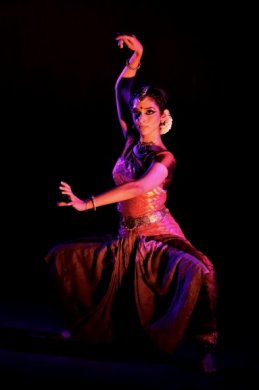
Pritika Krishnakumar 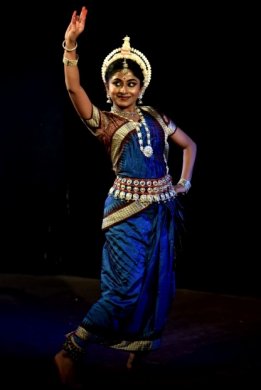 Tulika Tripathy Tulika Tripathy who has been associated with Odissi for the past eighteen years, has been trained by Gurus Kumkum Mohanty, Kasturi Pattnaik and Debi Basu. She performed the Mohana Pallavi choreographed by Guru Kelucharan Mohapatra especially for Sanjukta Panigrahi, with music by the legendary Pandit Bhubaneswar Mishra. The hall resonated with the beautiful Odissi music, as Tulika came centre stage. It was a delight to see her Pallavi unfold on stage. The third performer was Namrata Mehta, disciple of Daksha Mashruwala, who has been dancing since the last twenty years. She performed an Oriya abhinaya "Ahe nila saile" choreographed by Guru Kelucharan Mohapatra and based on a song written by poet Salabeg. He was an ardent devotee of Lord Jagannath but being a Muslim, he wasn't allowed to enter the temple. He also suffered from leprosy. He wrote this song to express his anguish and his desire to surrender himself at the lotus feet of the Lord. Namrata was able to express the poet's pain and anguish realistically through her dance. 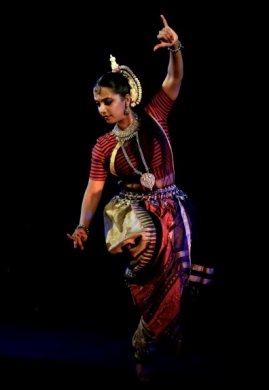
Namrata Mehta 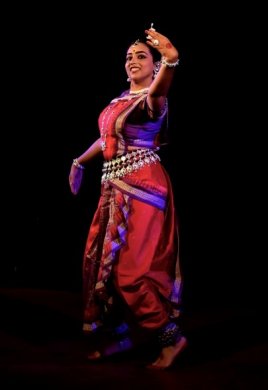 Shivangi Panigrahi Young Shivangi Panigrahi is the granddaughter of Sanjukta Panigrahi and is learning Odissi from Guru Ratikant Mohapatra. She performed the Kirawani Pallavi choreographed by Kelubabu to music by Pandit Bhubaneswar Mishra. Her performance could have been better, but she is still learning and has a long way to go. Jhelum Paranjape had been very close to Sanju nani (older sister in Odiya) and Raghu bhaina (brother-in-law). She was encouraged by this wonderful couple to excel in her chosen art. Jhelum had choreographed a dance especially for this Mahotsav. She chose two ashtapadis from the Geeta Govind which were set to music and sung by Raghunath Panigrahi for his private album. She first danced to "Lalita lavanga lata" where she portrays the bounties of spring and the longing for Krishna in the hearts of the Gopis, explained to Radha by her sakhi. Seeing Krishna amongst so many gopis, hurts and angers Radha. In "Mamiyam," Jhelum portrayed a remorseful Krishna who is full of guilt for having broken Radha's heart. Raghunath Panigrahi's voice added to the ethereal quality of this abhinaya piece which was highly appreciated by the senior dance gurus in the audience. 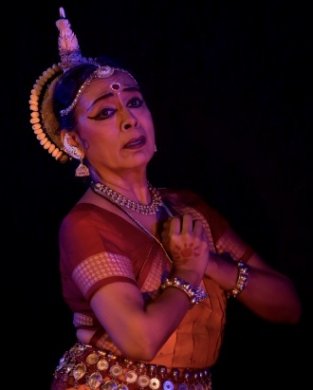
Jhelum Paranjape 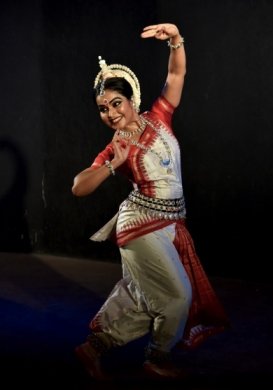 Rajashri Praharaj Rajashri Praharaj of Srjan, Bhubaneswar, is a disciple of Ratikant Mohapatra and performs both as a soloist and as a member of Srjan ensemble. She performed the Yugma Dwanda Pallavi choreographed by her Guru to music composed by Raghunath Panigrahi. Rajashri's performance was flawless. She has internalized the Odissi style and made it her own. Her footwork was strong and in total tandem with the music. The audience enjoyed this performance thoroughly. Guru Kumkum Mohanty is a contemporary of Sanjukta Panigrahi and they both learnt Odissi from Guru Kelucharan Mohapatra. She has published two books on the grammar of Odissi dance. She did an abhinaya to an Oriya song "Braja ku chora" written by poet Gopalakrishna. This song is about mother Yashoda cajoling and even terrorising little Krishna to go to sleep. Kumkum Mohanty played both the parts of Yashoda and Krishna convincingly. The audience identified with her and watched her play out the antics of little Krishna with delight. 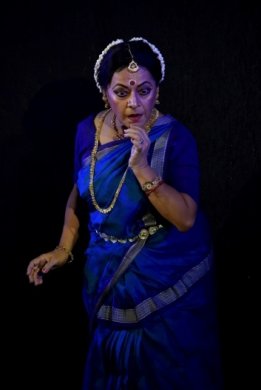
Kumkum Mohanty  Ratikant Mohapatra 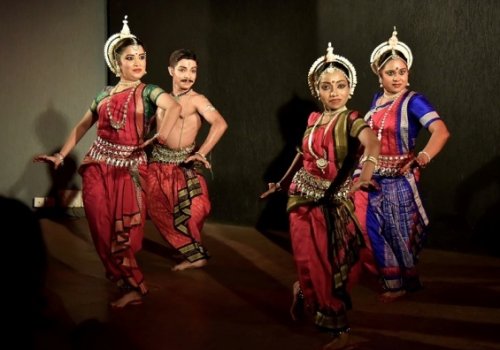 Smitalay dancers Ratikant Mohapatra is well known as a dancer, percussionist, teacher, choreographer and archivist. He performed 'Shabari' based on the chaupais from Ram Charit Manas. He portrayed Shabari realistically - her gait, her failing eyesight, her strong faith and devotion to Ram. The audience could feel this devotion and the performance was greatly appreciated. The last performance for the evening was based on the Ardhanareeshwar Stotram by four young dancers from Smitalay - Dipali Tikam, Rupali Kadam, Apurva Dani and Sumedh Pawar. This piece was choreographed by Kelucharan Mohapatra for Sanjukta Panigrahi and it was one of her favourites. Ardhanareeshwar is the depiction of Lord Shiva in the half masculine, half feminine form. It involves both the tandav and lasya elements of dance. Therefore it needs both strength and grace. The four artists did full justice to the choreography and ended the evening with a power-packed performance. The evening was a heartfelt and sincere tribute to Sanjukta Panigrahi and a treat for the Odissi dance lovers of the city. Day Two Photo Credit: Arundhati Sethi The second event was held on the 25th of August in the premises of Smitalay itself. It was a tete-a-tete with Guru Kumkum Mohanty about her life's journey with Odissi and her association with both Sanjukta and Raghunath Panigrahi.The conversation was held in the dance hall of Smitalay, with big pictures of Guru Kelucharan Mohapatra, Sanjukta Panigrahi and Raghunath Panigrahi looking down upon the proceedings. The audience consisted of Odissi dance teachers, performers, students and rasikas of different age groups. Kumkum Mohanty spoke on how she began learning Odissi from Guruji at a very young age. Those were the early days of Odissi. She talked about Guru Kelucharan Mohapatra as a dance teacher, choreographer, percussionist, costume designer and make-up artist. She remembered the innumerable dance dramas Guruji choreographed with Sanjukta Panigrahi and herself in the lead roles. Sanjukta usually played the male role. The rehearsals of these dramas happened at the All India Radio station, Cuttack. Composer Pt Bhubaneswar Mishra, Kelubabu and singer Rakhal Mohanty all worked together. Guruji was at his creative best at that time. He would be creating two pallavis at the same time, one with Sanjukta and the other with Kumkum Mohanty. They would work on a Pallavi at her home, late into the night and she had to remember all of it for him to continue with the choreography the next day. If she forgot, Guruji had to choreograph it all over again. Kumkum said that she would hold on to it all day long through her college lectures and other chores for Guruji to work on it at night. 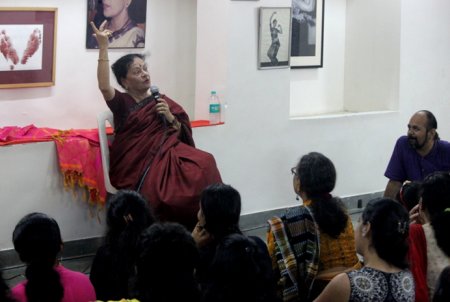 Kumkum Mohanty 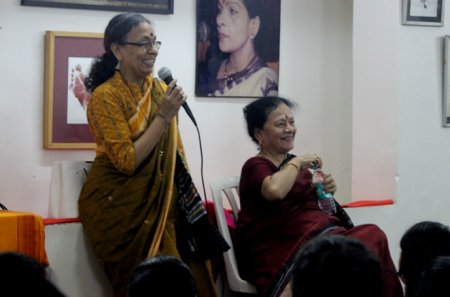 Jhelum Paranjape and Kumkum Mohanty Sanjukta took her dance seriously and was very quiet by nature. While Kumkum was very mischievous and used to play all kinds of pranks on Sanjukta while they were on stage, Sanjukta took all that in her stride and never complained. By then Sanjukta had married Raghunath Panigrahi who gave up his own lucrative career in music and decided to sing for Sanjukta only. Kumkum fondly remembered what a treat it was to dance to his singing. Sometimes he would get carried away with his own singing and sing differently but Sanjukta and Kumkum always managed to cover up for him. Later Kumkum stopped dancing because she got a job with the Govt.of India. So Kelubabu took her place and started dancing with Sanjukta. Until then Guruji was only teaching and choreographing but he began dancing to fill in for Kumkum Mohanty. Sanjukta, Raghunath Panigrahi and Guru Kelucharan Mohapatra travelled extensively and took Odissi all around the world. In the meantime, Kumkum Mohanty had codified all of Guruji's work so that she could remember it all. That's when she realised that all this work had to be documented. Her wish was fulfilled when she was made the special secretary in the ministry of culture, Govt.of Odisha. She set up the Odissi Research Centre and worked with the three main gurus, Pankaj Charan Das, Kelucharan Mohapatra and Debaprasad Das, to come to a consensus regarding the grammar of Odissi dance. She would also consult Sanjukta Panigrahi and Sonal Mansingh and check things with them because they were actively dancing then. She said that "Sanju nani and Raghu bhaina" were very supportive of this endeavour. Finally Kumkum published two books on the grammar of Odissi - The Odissi Pathfinder 1 and 2. She talked about Sanjukta's wish to teach dance to students. She had even built a hall in her house to hold her classes and shown it to Kumkum Mohanty, but she never got around to teaching because she fell very ill and succumbed to cancer. Her husband was devastated. He almost gave up singing after Sanjukta was gone. Listening to Kumkum Mohanty talk was a very humbling experience. We all realised the hard work that has gone into making Odissi the way we know it today. This talk was followed by a question answer session. The evening was enjoyed by one and all. The Sanjukta Panigrahi Mahotsav ended on a meaningful note. |